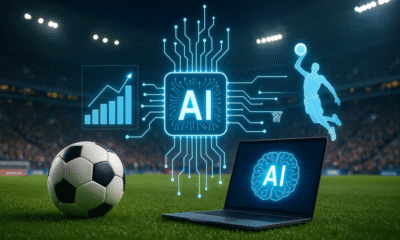Thought Leaders
Digital Humans Are Not Just AI with a Face

Digital humans used to be simple chatbots that often misunderstood questions, which many people found frustrating. Now, they've evolved into advanced virtual agents that can communicate as effectively as the best customer service representatives, possess expert-level knowledge, and look strikingly like real humans.
These advanced digital beings do much more than just add a face to customer service; they are revolutionizing how we think about and use artificial intelligence. They're taking on complex tasks that used to be done only by humans, from handling customer inquiries to performing specialized backend operations. Let's dive into how digital humans are reshaping our interactions with technology in everyday life.
The Evolution of Digital Humans
Originally conceptualized as visual enhancements to existing AI systems, digital humans have rapidly evolved. With advancements in natural language processing, emotion recognition, and machine learning, these entities are now capable of performing complex tasks, making decisions, and interacting in emotionally intelligent ways. This evolution marks a shift from viewing them as mere representations of humans in the digital world to recognizing them as dynamic agents capable of enhancing the customer experience profoundly.
More Than a Just AI with a Face
Digital Humans are not simply glorified chatbots. They leverage cutting-edge AI for natural language processing, allowing them to understand complex queries and even respond to emotional cues. This level of sophistication enables them to engage in natural, flowing conversations, fostering a sense of connection with the customer.
But Digital Humans are more than just avatars. They are equipped to handle real-world tasks. Imagine a digital banker who can answer your intricate financial questions, analyze your spending habits, and even offer personalized investment advice. This level of functionality surpasses the limitations of traditional chatbots, creating a more efficient and satisfying customer journey.
Digital Humans in Action
Digital Humans come with human-like problem-solving skills. They can analyze big amounts of data, learn from each interaction, and adapt their responses to provide efficient solutions. This cognitive ability allows them to not just answer questions, but to anticipate customer needs and proactively offer assistance. The potential of Digital Humans is already being realized across various industries.
Embassies: Imagine a multilingual digital assistant at an embassy, guiding visitors through the visa application process, answering frequently asked questions, and even translating documents in real-time.
Healthcare: Digital humans provide support in healthcare by facilitating communication that is not only informative but also empathetic. They are used for various purposes including guiding patients through treatment plans, providing mental health support, and enhancing patient engagement through empathetic interactions.
Law Enforcement: Police forces are exploring the use of Digital Humans for investigative work. These AI-powered assistants can analyze witness statements, identify patterns in crime data, and even generate simulations of potential scenarios, aiding detectives in their investigations.
Airlines: In the airline industry, digital humans are assisting with check-ins, answering travel-related queries, providing multilingual support, and offering personalized travel recommendations. They also help train staff by simulating customer service scenarios, improving operational efficiency and passenger experience.
Finance and Banking: Digital Humans are being implemented in ATMs and online banking platforms, offering personalized financial advice and assisting with complex transactions.
Sales: Digital humans are being utilized as sales assistants, capable of conducting real-time, personalized conversations that guide customers towards making purchases. They help in building trust and educating customers, leading to increased conversion rates and more effective completion of online transactions.
Human Resouces: Digital humans in HR streamline recruitment and onboarding by conducting interviews, answering FAQs, and guiding new hires through processes, enhancing the efficiency and engagement of HR operations.
These examples demonstrate how digital humans are not just limited to customer service roles but are versatile tools that can enhance various aspects of business operations and customer interactions across industries. Their ability to process and analyze vast amounts of data in real time allows them to perform tasks that were traditionally handled only by humans, thus redefining the scope and potential of AI in everyday applications.
What's the Technology Behind Digital Humans?
The operation of digital humans relies on a complex interplay of cutting-edge technologies. At its core lies deep learning, a form of artificial intelligence that allows these entities to continuously learn and improve. Through massive datasets, deep learning models empower Digital Humans with the ability to recognize speech and text inputs with remarkable accuracy. This goes beyond just the literal meaning of words. They can understand the nuances of pronunciation, intonation, and even written slang, idioms, and typos.
Digital Humans aren't simply programmed with responses. Sentiment analysis algorithms become their emotional intelligence, allowing them to analyze the subtext in user communication. They can detect frustration, excitement, or hesitation and tailor their responses accordingly. This fosters a more natural interaction, building trust and connection with the user.
But Digital Humans don't stop learning after their initial training. Continuous learning mechanisms are built-in, allowing them to constantly evolve. As they interact with users, they can identify new trends and adapt their responses to better serve customer needs. This eliminates the need for manual updates, ensuring Digital Humans remain relevant and effective over time. In essence, Digital Humans operate like intelligent virtual sponges, constantly absorbing information and refining their abilities to deliver a more natural and effective user experience.
The Future of Digital Human Interaction
As technology advances, the potential applications of digital humans are bound to expand. Future developments might include more nuanced emotional intelligence, better integration with IoT devices, and even roles in managing other AI systems. The interaction between digital humans and users will likely become more seamless and indistinguishable from human-to-human interactions.
Conclusion
Digital humans represent a significant innovation in the realm of AI, poised to redefine how businesses interact with their customers. Far from being just an AI with a face, they are complex systems capable of driving real engagement and offering solutions that are both technically advanced and emotionally resonant. As we stand on the brink of this new frontier, it's clear that digital humans are not just the future of customer experience—they are the present.












